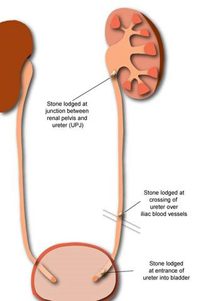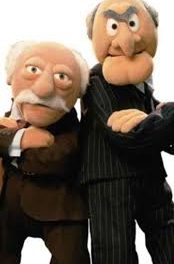 One should be reasonable in one’s demands on life. For myself, all that I ask is: (1) accurate information and a coherent world; (2) warm, loving relationships with family and friends; and (3) no more kidney stones, please.
One should be reasonable in one’s demands on life. For myself, all that I ask is: (1) accurate information and a coherent world; (2) warm, loving relationships with family and friends; and (3) no more kidney stones, please.
Kidney stones are dreadfully serious business, potentially life threatening at their worst and astoundingly painful at their best. Some interesting quotes about these dreaded pebbles have rocked us over the years:
“The Atlanta Hawks are a bunch of guys who would prefer to pass kidney stones than pass a basketball.” – Bob Weiss, coach
“Calcification is the hardening of body tissues by calcium salts or deposits. Although calcification itself is not considered a disease, it has been shown to be a significant contributing factor in nearly every known illness and aging condition, including heart disease, kidney stones, gallstones, chronic inflammation, arthritis, cancers, cataracts, eczema, psoriasis, and even wrinkles.” [Wrinkles?] – David Wolfe, American entrepreneur and author
“I listen to, like, funky Chicago blues. I love blues, but I love the funky, happy blues. There’s a song about pretty much everything, including kidney stones, believe it or not. So there’s something there for whatever you happen to be suffering, you know?” – Sinead O’Connor, singer-songwriter
But I’m getting ahead of myself. The stones came up after my revolving door interaction began with the emergency room folks at Beaufort Memorial Hospital this year. I believe I’ve now checked in there ten times recently, and been admitted to the hospital on two of those occasions. As one of my doctors said, “You’ve got a lot going on.”
The diagnoses built upon each other until I hit the ‘itis trifecta’ and then some. Let’s see, in descending anatomical order, I rang the diagnostic bell with: esophagitis, gastritis, duodenitis, colitis . . . Or, perhaps, one God-what-did-I-ever-do-to-deserve-this-unending stomach ache? Kidney stones, for those of you fortunate enough to have never encountered them, are—according to the Mayo Clinic—
“Hard deposits made of minerals and salts that form inside your kidneys. Kidney stones have many causes and can affect any part of your urinary tract — from your kidneys to your bladder. Often, stones form when the urine becomes concentrated, allowing minerals to crystallize and stick together. Passing kidney stones can be quite painful, but the stones usually cause no permanent damage if they’re recognized in a timely fashion.”
Ah, “quite painful” and “usually.” Truer words. But rather than dwelling on the clinical profile of the ‘itis’ trifecta and six mm stone (a beauty and often not passable without surgical intervention), let’s back up the truck (ambulance?) to my first few trips to the ER.
Attached to Beaufort Memorial Hospital is a catchall facility that caters to often sudden, painful conditions that can’t wait. Typical maladies afflicting patients include chest pain, severe bleeding, blurred vision, changes in mental functioning, and acute injuries or illnesses. Poisoning can be added to the list, as one young woman who came in when I did had what appeared to be a stingray puncture wound on the top of her foot, or at least it was a dead match (is that a poor choice of words here?) for a photograph she and her husband Googled on their phone.
In my case, the presenting problem involved the worst, most persistent stomach pain in my life. A dull, chronic, debilitating discomfort that interfered with my appetite, yes, but also my overall well-being and ability to carry out everyday activities, even reading. By the tenth ER visit, I had lost 35 pounds in six months due to basically having little appetite. Along with that, I had to force myself to drink any water, a sensitive issue after four previous stones.
By my fourth or fifth ER visit, we all seemed to know the drill. Give the suffering old geezer medicine to coat and soothe his stomach and something else, most often hydromorphone (Dilaudid), for pain control. I was given morphine for my first stone in the late 1990’s in Connecticut, and Dilaudid seemed much stronger. Often, I was also given oxygen while various blood and urine tests were run in the lab. The ER team also did X-rays, CT scans and EKG’s. The various GI ‘itis’ diagnoses followed the scans while the stone showed up on the final X-ray images. Gosh, doesn’t all this sound like fun? So, Jack, you hotshot student, what are some of the things you learned passing in and out of the ER and hospital? Glad you asked.
For one thing, the ER is actually a warren of several dozen chilly rooms, each with an overhead TV to distract you from the often rising misery quotient and let you know how the volcano victims in Hawaii were faring (probably worse than you, but who knows?).
Second, nurses earn every single penny they are paid and then some. My nurses—all of them—were focused on my care and comfort, applying the best talent available (e.g., snagging the best IV person on the floor whenever challenged), calming, polite and just plain pleasant. When I rang the call bell and asked for my nurse, she responded quickly (can I get another blanket, pain med, glass of water, urinal, ice cream; when am I due for… whatever… bi-bing, bi-bing). Fittingly, May 6-12 was National Nurses Week, denoting Florence Nightingale’s 100th anniversary of service during the Crimean War.
Among my nurses, many stand out, including Michelle, Katherine, Sissy, René, Mary, Jennifer, and the inimitable Tony. His badge says Anthony, but he’s a Tony all the way, a Tony of all trades. A whiz with an IV stick or any other technique, terrific bedside manner and, in the words of one of his colleagues, “hysterical.” No argument from me.
Persistent pain is a fearsome creature. For me, its worst manifestation is stomach (ok, abdominal) pain as it limits my ability to do almost anything. Even reading or eating. Or talking. Or just being polite.
Once we had the pain under control, I could feel my regular self bubble back to the surface. Not that I’m anywhere near perfect, but it felt great to be “me” again and not worried that another bout of severe discomfort was just around the corner. Well, one exception. When faced with a catheter if a urine sample wasn’t forthcoming, the very fear of that kind of discomfort pushed me over the line into a tiny bit ornery. Alright, bristly. Snarly?
So many stray thoughts ricocheted through my head while waiting in the bare walled ER rooms or while waiting for some help or a pain med to kick in. The whole field of health care, the intense training that goes into becoming a nurse, a doctor, a technician, you name it. I thought about people who lacked insurance (thank you Medicare!) and folks who live several hours away from a good hospital. I thought about what hospitals do when confronting a power outage or terrible storm. I thought about the Affordable Care Act. About seeing our lads again, rejoining Jane, goofing around with our dogs. Making sandwiches or pancakes for all of us. Sharing a favorite old story.
The word “netherworld” came to mind once or twice, but more often words like saved again or thank God you’re here. Like when my urologist effectively said ‘see you on the other side’ just before proceeding with my anesthesia and then lithotripsy to crush my kidney stone into sand. Hunger.
Savior, too. Redeemed. Recovery.
Best nurses on the planet. Thank you, thank you ladies. And gentlemen. Thank you all! Till we meet again, as long as it’s on the outside.







